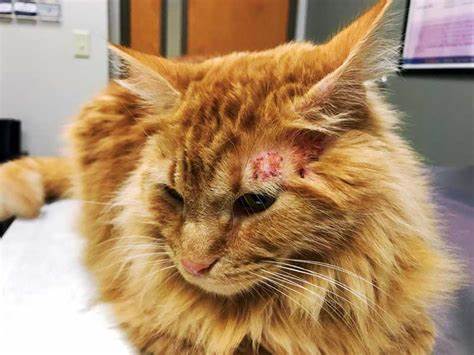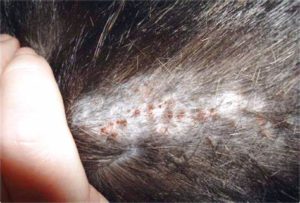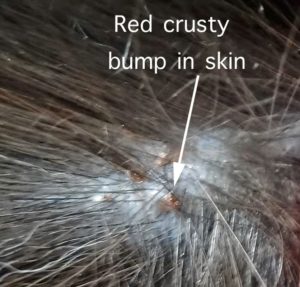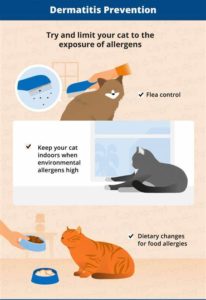Scabs Here, There, Everywhere

Are unsightly and uncomfortable scabs making YOUR kitty itchy and irritable? If so, what’s causing them?
One of the main culprits is miliary dermatitis, where itchy scabs appear on a cat’s neck, back and tail. Most often the result of a fleabite allergy, whereby a cat is allergic to a substance in flea saliva, a single bite can trigger severe itching in her. Although you’re unlikely to find fleas on your affected cat due to her fastidious grooming habits, you will be able to see flea droppings — composed of digested blood.
Some cats have food allergy dermatitis and may exhibit hypersensitive reactions to one or more components in their diet. Other possible causes of allergies include atopy, a type of allergic reaction in response to inhaled allergens, and contact dermatitis or contact allergies. Some cats may react adversely to materials in their owners’ bedding, carpets or rugs. Seasonal allergens – from pollen in the air to grasses, weeds and bushes — can also cause intense itching in especially sensitive cats, not to mention chemicals commonly used in households and on gardens and lawns.
Next on the list of possibilities are skin parasites such as ticks, lice and mites, nutritional deficiencies due to an unbalanced or inappropriate diet, and immune-mediated skin diseases. While they themselves don’t cause a cat’s scabs, her frenzied scratching, chewing and licking in an attempt to find relief from the itching will – by eventually breaking the surface of the skin. The longer she claws at the scabs, the greater the chance of secondary bacterial or fungal infections, making treating her all the more complicated. It’s therefore essential to bring YOUR unhappy kitty to the vet as promptly as possible.
The diagnosis of miliary dermatitis is based primarily on your cat’s medical history and her symptoms. Your vet will, in all likelihood, check for signs of fleas and flea dirt, collect some skin scrapings, run allergy tests and take biopsies if necessary. You may even be referred to a veterinary dermatologist.
Ultimately, treating her scabs and itchy skin will depend on identifying the trigger and then, relieving her symptoms. If a flea allergy is to blame, your vet will prescribe a flea medication for at least two to three months. If it’s a mite or lice infestation, medicated baths or sprays should help. If it’s a food allergy, a hypoallergenic food trial (without the offending allergens) may make all the difference. She may also be put on a brief course of corticosteroids or other anti-inflammatory drugs to help ease her itching while any other prescribed medication works to eliminate the root cause of her condition.
Should a secondary infection be involved, your vet will prescribe a round of antibiotics or antifungals for a given period of time. But remember: even if her skin problem begins to resolve itself within a few days of starting any medication, you MUST finish the entire prescription to prevent it from recurring, which can be more serious and more difficult to address. Additional protocols may also include giving her antihistamines and/or cyclosporine and supplementing her diet with essential fatty acids.
Fortunately, most cats diagnosed with miliary dermatitis have an excellent prognosis. But to err on the side of caution and keep it, wherever possible, from becoming an issue in the first place, your cat’s preventive health program should include a monthly flea preventative to ensure she’s adequately protected throughout the year. If your cat spends any time outside, keep her inside instead, thereby reducing both her exposure to various outdoor allergens and keeping her away from any cats potentially infested with fleas, mites and other parasites.



